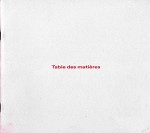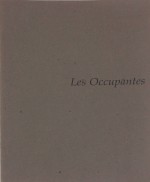
USED/Goods, a large scale exhibition featuring works by twelve Montreal artists created specifically for the Salvation Army Thrift store on Notre-Dame West. USED/Goods was organised by Cut Rate Collective in cooperation with the Salvation Army as a means for artists to address timely and pertinent social issues from a local perspective.


This publication expresses the complicity of two individual art practices, and complements the installation presented in the gallery. D'elles is, first and foremost the meeting between Loly Darcel and Lorraine Oades, one marked by the presence of the women who inhabit this collaborative work. D'elles enacts a shift toward the space of the other, an investigation of social and cultural environment which fashions our understanding and way-of-being in the world.


To inaugurate the Studio's new exhibition/gallery space, we are pleased to host the work of Lorraine Oades. Lorraine Oades's sculpture/installation works incorporate time-based media such as sound, video and film in order to invite viewers to engage physically with the work and explore their own creative potential.

Marquant le vingt-cinquième anniversaire d’Optica, cet événement réunissait un ensemble de practiques contemporaines mettant l’accent sur l’expérience urbaine, sur la fonction structurante et organisationnelle de la ville et sa dimension communautaire. Une série de conférences posait en complément la question de l’art public à l’échelle de cette expérience et du quotidien. Procédant par appel de dossiers et sur invitations, les commissaires ont retenu des œuvres éphémères, presques effacées, et des actions qui furent présentées sur différents sites du territoire urbain de Montréal.

The proposal to la Centrale for this project was to work with the gallery, the coordinators, and the members to bring the artwork of Lorraine Oades and Paméla Landry to the gallery’s public: to speak with this specific audience, with you, in a special place, in the gallery and in this book, and to consider “a material practice as a research of identity”.



Under capitalism, all is spectacle. Branding is the antithesis of neighbourhood. How can the symbolic language inherent to branding adjust to a process that includes the local community: the residents who study and work in a neighborhood, plus the daily flux of permanent and temporary occupants.

This catalogue, which documents Contemporary Art Forum, Kitchener.01, is a testament to the incredible work of a group of artists. Each year an exhibition takes place at the site of Kitchener’s city hall. Artists’ projects, performances, panel discussions, talks and screenings are presented outside the gallery setting directly in the public sphere. These activities seek to demystify contemporary art practice, encourage dialogue about contemporary art and provide an environment for artistic exchange.


In the spirit of a souvenir album or ship’s log, Memento was born from the desire to relate and document the experience of the residency. To do this, we asked the artists to supply us with a short text on their stay at Est-Nord-Est: impressions, thoughts, working notes. To these texts are added photographs of the studios and the works, taken by the centre’s staff or by teh artists themselves.


The Space Between is a space where experiments, risks and uncertainty are permitted. It is a period of time when the artist, having the beginnings of a personal vision language, is free to choose any imaginable direction in art. In romantic terms it is “the moment of truth” in the formation of an artist’s expression, and so should be acknowledged in the proper perspective.


Straight from the kitchen, we bring you endnotes, an artists’ writing publication that gathers the works of twenty eight artists from Montréal, Toronto, Vancouver, New York and Glasgow, who accepted the invitation to contribute to this potluck book. Among various styles from the poetical, fictional, autobiographical and formats of advertisements, wish lists and informative dialogues, you will find writings that can be considered as leftovers of art production.


The Warehouse Show was an historic event demonstrative of the indigenous pool of talent, the Vancouver art scene. This catalogue attempts to capture a sense of the process which resulted in "the largest art exhibition in the history of British Columbia." In addition to art images and curatorial statements, other pertinent documents are included to underscore the significance of the way the show evolved.


In Les Occupantes we are "in residence." Our exhibition is collectively approached, developed and organized. The title is intended to suggest a transitory occupation of space and, in referring to the local, to emphasize a state of "situatedness." In this construction, language makes for a revelation. The use of French refers to our affective relations to a specific geo-political location, Montréal, and in grammatic terms conveys sex determination. Women's voices are the first register of an embodied production. On another register, our social and discursive emplacement takes into consideration feminist theories of difference. What touches me is a re-appropriation of domestic space not hopelessly mired in stereotypical ideas of viewing.


April 12-15th 2005
Goldsmiths College, University of London, UK
Submission Deadline: 1st October 2004
Creativity and Cognition has evolved into an ever increasingly mature field of research and practice since its starting points in the early 1990s. The main theme of the 2005 conference is the creative process and the creation of artefacts: understanding creative practice, art works employing digital media and creativity support tools.



























































